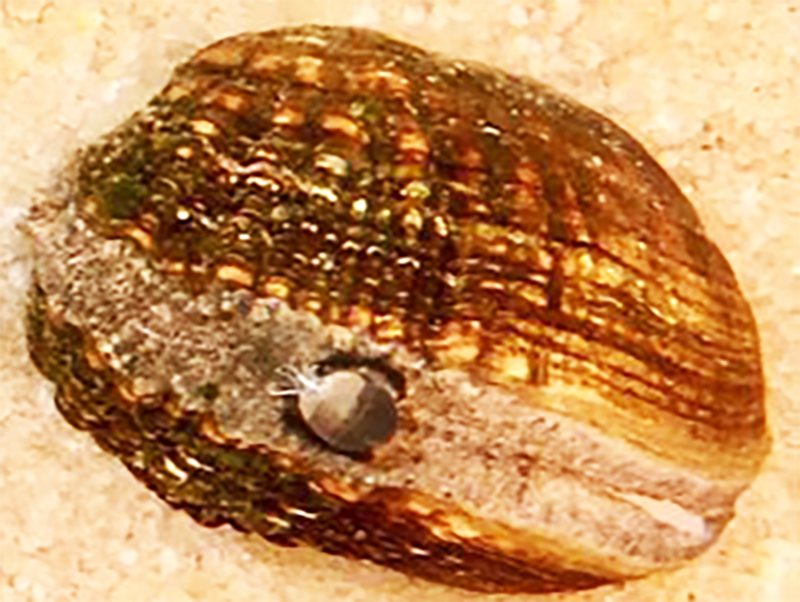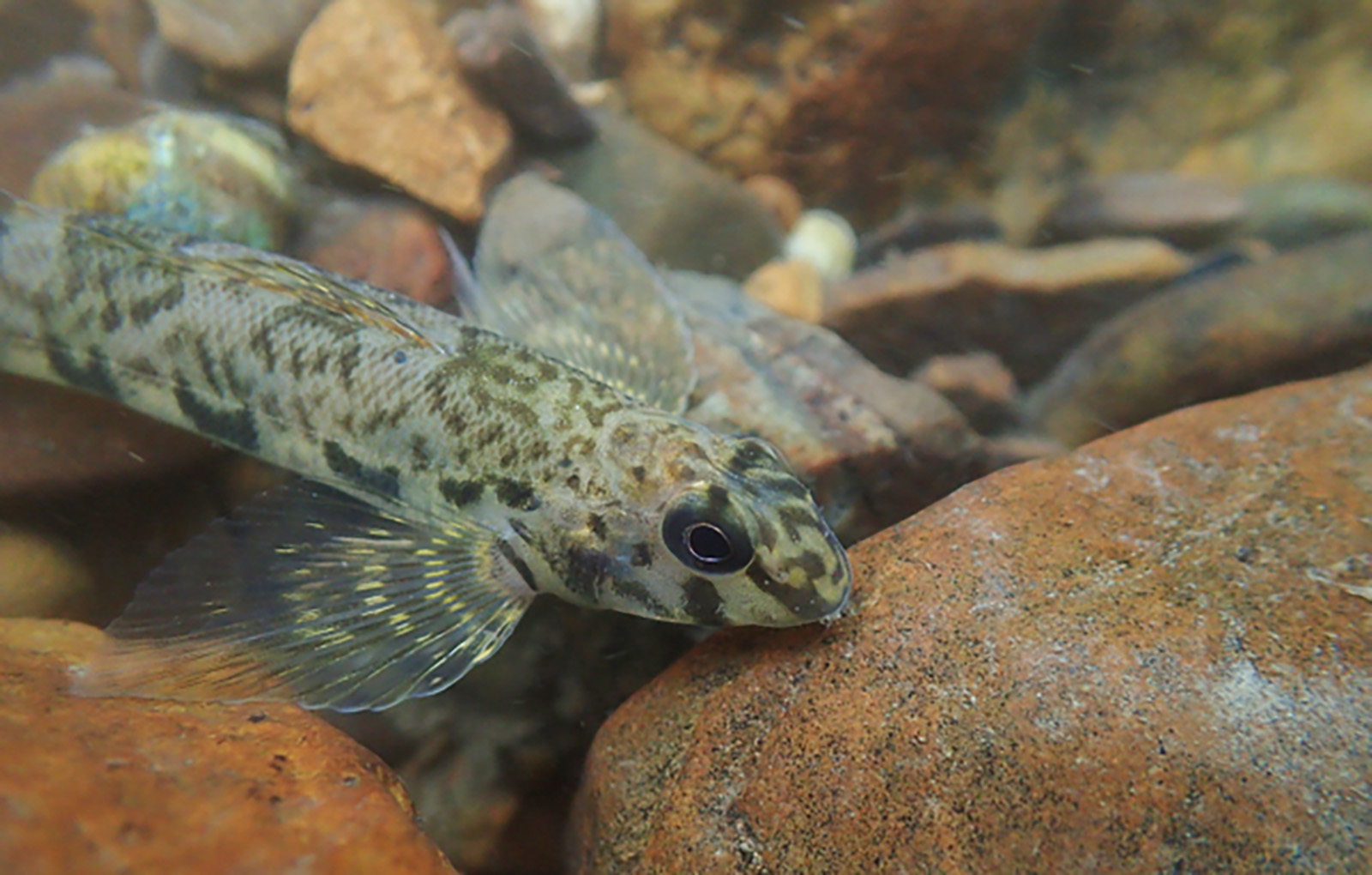By Molly Kirk/DWR
Photos by Tim Lane/DWR
When does a mollusk imitate another mollusk to fool a vertebrate into hosting its babies? When it needs to complete its life cycle, of course!
It might sound like a bad biologist’s joke, but that’s exactly the process the birdwing pearlymussel (Lemiox rimosus) undertakes to reproduce. This species of mussel, one of the first five mussel species added to the Endangered Species List in 1976, attracts its host fish with a lure that looks like a snail.
All freshwater mussels require a different host fish for their microscopic babies, which are called “glochidia,” to live on parasitically for a short time. When an adult mussel releases its glochidia into the river they find refuge by clamping onto a fish’s gills for a period of weeks or months, depending on the type of mussel. Eventually the ride on the fish’s gills ends when the mussel drops off to the river bottom to continue its life cycle.
Mussels are cunning bivalves—gravid females have adapted the ability to sense when a fish is close before releasing their babies, or even to “trick” a fish by wiggling a body part that imitates a minnow, luring it in close before exploding a cloud of glochidia point blank into the fish’s mouth and gills when the fish strikes the decoy. This symbiotic connection between mussel and fish is a glimpse into nature’s miraculous order—the host fish provides a safe haven for the glochidia, while the adult mussel returns the favor by filtering pollution from the water and providing structure for fish on the river bottom.
It also makes it quite difficult to propagate, or produce young from, mussels in a lab setting. It’s not as simple as mammals breeding.
The last two wild populations of birdwing pearlymussel inhabit the Clinch River in Virginia and the Duck River in Tennessee. “It used to live in thousands of river miles of the upper Tennessee river basin, but it’s been extirpated from everywhere but those two locations,” said Tim Lane, Southwest Virginia mussel recovery coordinator for the Virginia Department of Wildlife Resources. Lane and his team at DWR’s Aquatic Wildlife Conservation Center (AWCC) in Marion, Virginia, are trying to change that.
For more than 20 years after the birdwing pearlymussel was first listed as endangered, there wasn’t much progress on ways to propagate them to restore their populations. “No one even knew they had snail lures to draw in the fish hosts until the mid-1990s, so they went 20 years of being listed that we didn’t even know that basic fact about them,” said Lane.

A birdwing pearlymussel exhibiting its snail lure.
In the early 2000s, AWCC biologists worked on strategies to propagate captive birdwing pearlymussel that had been captured from the wild population in the Clinch River. The intricacies of the mussel species’ reproduction process made things a bit complicated, and also highlighted just how detailed the interconnectivity of aquatic species is.
“Birdwing pearlymussels seem to be very specialized in their host use,” said Lane. “Some mussels can use three or four or five different fish as hosts, where this species can only really use two—primarily the greenside darter (Estheostoma blennioides). We think these species co-evolved; in the tree of life the two species are linked. Once you learn about that snail lure, if you knew anything about fish, you’d think, ‘greenside darter feed almost exclusively on snails in the river, so yeah, they’re perfect for each other.’ ”

The greenside darter, the host fish for the birdwing pearlymussel.
The birdwing pearlymussel larvae (glochidia) also seem to do better when the host fish are in cooler temperatures of water than other mussels’ host fish. In addition, they stay on the host fish longer than other mussel species. “Other species we work with develop in a more predictable manner; they drop off and metamorphose within 14 or so days post-inoculation,” said Lane. “The birdwing pearlymussel can come off a little bit at a time for up to six to eight weeks after we inoculate them. It’s almost like they need that extra time on their host fish. Maybe that also increases the chances of the fish moving away from the location where they met up with the mother mussel. That way they’re more likely to drop off further up or down stream from their mom, where they’re able to do more for the population. We’re not really a hundred percent sure—that’s all kind of speculation. But they definitely have a much longer metamorphosis period.”
Because of the mussel species’ small size and limited numbers, it was difficult for AWCC staff to propagate them in large numbers. “We don’t have as many babies from a single batch like we would for other species. But what we can produce seems to have fairly high survival in the hatchery, up to the size we need them to stock out,” Lane said. “It seems year after year, we do a little bit better and it’s a little more routine for us.”
The AWCC first released 19 captive-propagated birdwing pearlymussel juveniles into the Clinch River in Virginia in 2011, and in the years since, they’ve stocked a total of 2,698 juveniles into the Clinch and Powell rivers in Virginia, the Paint Rock River in Alabama, and the Nolichucky River in Tennessee. “It doesn’t sound like enough to necessarily turn the tide for their imperilment status, but it allows us to move them to these rivers where they belong,” said Lane. “Ultimately the goal is to get them off the Endangered Species list and back to functioning on their own again. That’s further out, but we have to start somewhere.”

Some propagated birdwing pearlymussel ready for stocking.
The Endangered Species Act has helped wildlife agencies establish a permitting process that works toward improving water quality for mussel species like the birdwing pearlymussel. “You can see how human impact, like letting mud go down the river more frequently, would interfere with mussel reproduction, because now the fish wouldn’t see the mussel’s lure waving,” Lane said. “Or if you put a dam up, that fish that used to swim by mussel lures every spring when it went to spawn instead runs into a dam. So, the fish never make it up to where the mussel is waiting. Without the host fish, that mussel is going to live out its life and never reproduce. That’s a trend we see with a lot of mussels that are imperiled—dam building blocked access to host fish and runoff of mud and sewage interfere with the really important visual process that’s required for them to complete their life cycle.”
Virginia’s rivers are home to more than 75 species of freshwater mussels, so why is saving the birdwing pearlymussel so important? “Mussels do so much for improving water quality and starting the food web that ultimately weaves up to us, having happy fish populations for us to explore and fish,” said Lane. “We need healthy fish populations, and you can’t have that without the mussels. It’s like taking the coral reef out and all the fish disappear—that’s the situation if we don’t have any mussels.
“A species like the birdwing pearlymussel is a smaller part of that ecosystem service, but the whole community of mussels is important. Again, like a coral reef, if you just have one type of coral, you only have one or two types of fish that really benefit from that. Where if you have a diverse coral reef, then you have all kinds of cool fish and squids and octopus, all that variety. The same applies to our rivers—the more diversity we have in that mussel community, the bigger the positive impact on the overall health of the river, from bottom to top.”
Lane and his team at the AWCC have successfully cultured and stocked 35 species of freshwater mussels, including the birdwing pearlymussel and another critically endangered species, the Appalachian monkeyface. They’re hoping that their efforts to boost the species’ populations could result in de-listing at some point in the future. “We’re their last chance; we’re like the firemen that come to the house that’s on fire,” Lane said. “I’m still compelled to run in there and do what I can. But there’s always the possibility we’re too late. But I can go to sleep at night kind of knowing I tried at least and maybe gave them a shot, and I can live with that. Ultimately, human behavior and societal choices will be required to save them, nationwide and worldwide. I hope I’m having an impact, but my AWCC team and I are just trying to buy them time.”


